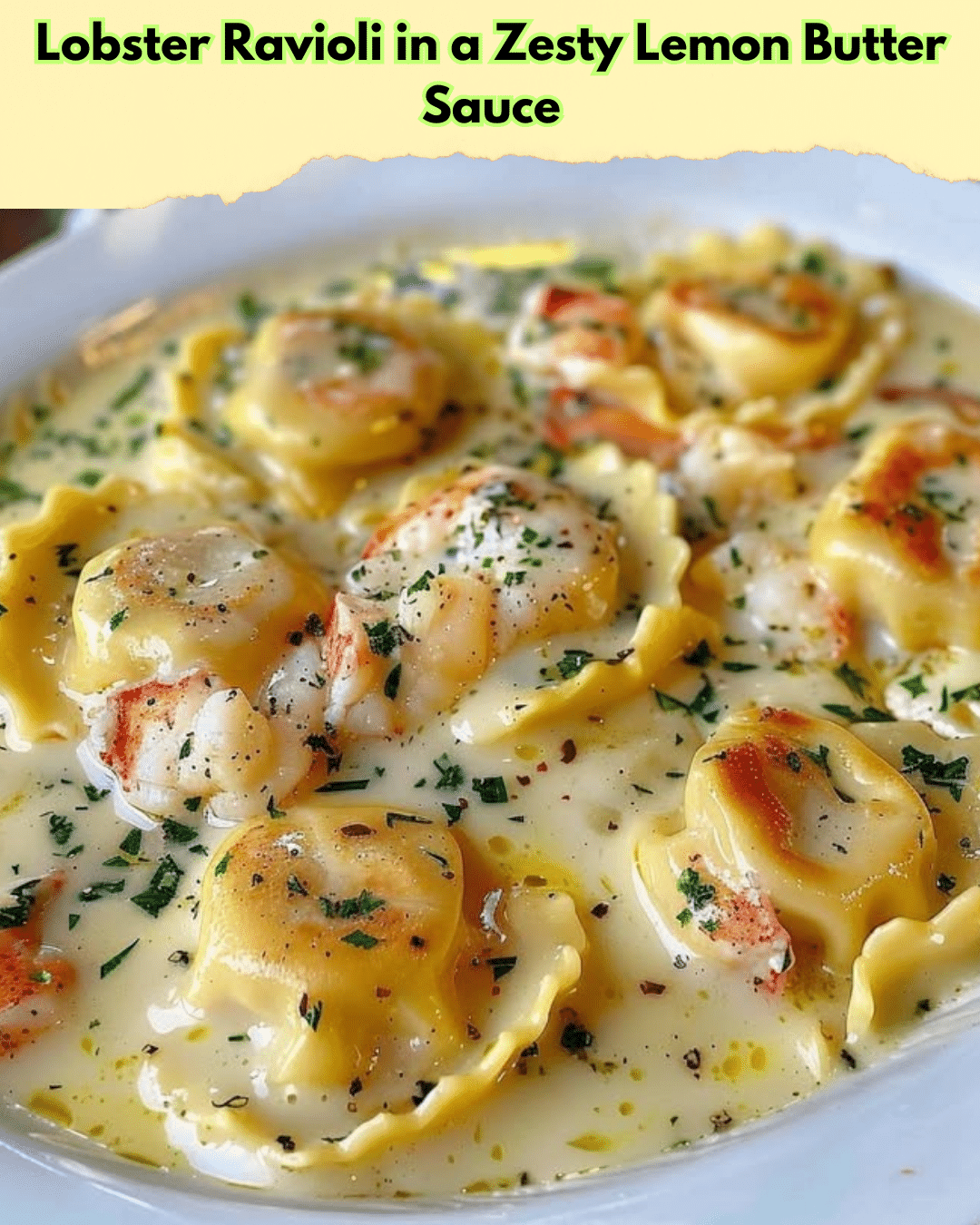Lobster Ravioli in a Zesty Lemon Butter Sauce: A Luxurious Delight
Elevate your dining experience with our Lobster Ravioli in a Zesty Lemon Butter Sauce. This exquisite dish pairs delicate lobster-filled ravioli with a vibrant, tangy sauce that perfectly balances richness and freshness. Whether you’re indulging on a special occasion or treating yourself to a weeknight delight, this recipe promises a unique culinary journey.
The magical combination of fresh lobster and velvety pasta creates a dish that’s both sumptuous and satisfying. With each bite, you’ll enjoy the refreshing burst of lemon zest mingling with the creamy butter sauce, offering an unforgettable taste sensation. The recipe is designed to impress, with the intricate textures of the ravioli encapsulating the savory filling and the sauce lending a glossy, mouthwatering finish.
Quick Recipe Highlights
- Flavor Profile: The lobster ravioli offers a rich, indulgent seafood flavor that is elevated by the freshness of the lemon in the butter sauce.
- Texture: Silky smooth ravioli filled with delicately cooked lobster meat, bathed in a buttery sauce for a luxurious mouthfeel.
- Aroma: Aromatic notes of lemon zest blend with the buttery undertones to create an inviting and mouth-watering smell.
- Visual Appeal: The vibrant yellow of the lemon butter sauce complements the elegant presentation of the neatly arranged ravioli, garnished with fresh herbs.
- Skill Level Needed: While intermediate cooking skills are beneficial, careful attention to detail is all you need to achieve perfection.
- Special Equipment: A pasta roller and a ravioli mold will help in achieving uniformity and accuracy in shaping the ravioli.
Recipe Overview
- Difficulty Level: This recipe is moderately challenging, requiring some experience with pasta-making techniques, but the step-by-step instructions simplify the process.
- Category: Ideal as a main course, it’s perfect for both casual meals and formal dining experiences.
- Cuisine: Rooted in Italian culinary tradition, this dish embodies the flair and finesse of Mediterranean flavors.
- Cost: With lobster as a prime ingredient, the recipe is a bit of a splurge, but the elegance and flavor of the dish are worth every penny.
- Season: Best enjoyed during spring or summer when fresh lobster is easily accessible and the zesty flavors align with the seasonal freshness.
- Occasion: Perfect for intimate dinners or special celebrations where you want to impress your guests with a gourmet experience.
Why You’ll Love This Recipe
Experience a medley of tastes and textures that will make you fall in love with every bite. The richness of lobster meat and the citrusy zing of the lemon butter sauce create an outstanding harmony of flavors. This dish not only satisfies the taste buds but is also visually stunning – a true delight for those with a taste for luxury.
Convenience comes in knowing the steps are simple once broken down, with most preparations comfortably done in stages. Preparing lobster ravioli can be a fun weekend project, and the sense of accomplishment enhances the deliciousness of the meal.
Nutritionally, lobster is rich in protein, essential for muscle repair and growth, while the lemon and parsley add a vitamin boost. This makes the dish a nutrient-dense choice for those who seek flavorful, yet nourishing meals.
Hosting a dinner? Lobster ravioli serves as an excellent choice, offering sophistication and grace on the plate, while being a conversation starter among your guests. It’s bound to charm and win praise from family and friends alike.
Moreover, the relatively higher cost of lobster is offset by the dish’s gourmet quality, making it accessible luxury dining at home. The pleasure and satisfaction derived from creating and enjoying this dish make it a worthy investment.
Historical Background and Cultural Significance
The origin of lobster ravioli lies in regions where seafood and pasta are gastronomic staples, particularly in coastal regions of Italy. The marriage of fresh lobster meat and delicate pasta showcases Italian ingenuity in turning simple ingredients into culinary masterpieces.
Lobster has long been a prized ingredient in many cultures, particularly in Mediterranean regions, where the ocean’s bounty plays a central role in the diet. As such, lobster ravioli is a testament to the rich maritime heritage and the celebration of nature’s offerings.
Over time, variations of this recipe have surfaced worldwide, with chefs infusing their touches. From creamy bisque-style sauces to spicy tomato accompaniments, lobster ravioli has evolved while maintaining its core essence of richness and freshness.
Regionally, the dish sees diverse adaptations, with New England chefs incorporating native ingredients like corn or local spices. These variations highlight the adaptability of the recipe to different tastes and traditions.
Ingredient Deep Dive
Lobster is at the heart of this dish, known for its succulent texture and sweet taste. Historically, it was a food for the elite, often associated with wealth and celebration. Today, it remains a symbol of indulgence across many cuisines. Nutritionally, lobster is a low-calorie, high-protein choice, contributing essential vitamins and minerals like B12 and zinc.
Select your lobsters wisely; fresh is always best. Look for lobsters with lively movements and intact shells. Store lobsters in a cool, moist environment, like the bottom drawer of your refrigerator, ensuring they are covered with seaweed or a damp cloth.
As for the pasta dough, made from simple ingredients – flour and eggs – it forms the foundation for the ravioli. The history of homemade pasta is rich within Italian households, with techniques and recipes handed down through generations.
Flour selection is key; opt for ’00’ flour for a silky texture, and when not available, all-purpose flour will also suffice. Store your flour in a cool, dry place, and be sure to sieve before use to avoid any lumps in your dough.
Common Mistakes to Avoid
- Overcooking Lobster: Lobster should be cooked until just opaque to ensure it retains its tenderness and flavor.
- Thick Pasta Dough: Ensure your dough is adequately rolled to prevent a chewy texture in the ravioli.
- Imbalanced Sauce: Balance is key; too much lemon or butter can overpower the dish. Taste as you go to adjust.
- Neglecting Salt: Salt the pasta water generously to flavor the ravioli as they cook, enhancing the overall taste.
- Rushing the Process: Allow your pasta dough to rest, enabling the gluten to relax for easier rolling.
- Incorrect Filling Amount: Avoid overfilling the ravioli to prevent bursting during cooking.
- Skipping the Seal: Seal the ravioli edges firmly to avoid filling leakage.
- Failing to Degrease: Remove excess foam and grease from the butter sauce for a cleaner finish.
Essential Techniques
Pasta Rolling requires a gentle touch and patience. Aim for an even thickness for uniform cooking. Mastery involves understanding the dough’s elasticity, rolling until it’s translucent yet still manageable.
Filling and Sealing Ravioli ensure perfectly shaped pasta pillows. Distribute filling evenly, avoiding air pockets which can cause ravioli to burst when boiled. Press edges firmly to seal, utilizing a touch of water if needed to ensure closure.
Sauce Emulsification combines the zesty lemon with rich butter. The key is to add butter slowly while constantly whisking, creating a perfect blend that coats the ravioli in glossy goodness. Avoid overheating the butter to prevent separation.
Pro Tips for Perfect Lobster Ravioli
Ensure impeccably fresh lobster for a superior flavor profile in your filling.
Let your pasta dough rest for at least 30 minutes after kneading—it’ll roll more smoothly.
Use a sharp knife or a pasta cutter to create clean edges for your ravioli, enhancing presentation and cooking consistency.
Chill your lobster filling slightly before using it to firm it up for easier handling.
Pre-cook a test raviolo to check the seasoning and adjust before filling the remaining dough.
Lemon choice matters; Meyer lemons offer a more subdued tartness, while regular lemons provide a sharper profile.
Variations and Adaptations
Regional variations can include a richer bisque sauce or incorporating local seasonings like saffron or basil.
Seasonal adaptations easily accommodate other seafood or shellfish when lobster is unavailable or out of season.
For dietary modifications, explore gluten-free pasta or cashew butter for those with lactose intolerances.
Flavor variations such as adding chili flakes to the sauce infuse an extra layer of warmth and spice.
For a more textural contrast, finish the dish with a sprinkle of toasted breadcrumbs or pine nuts.
Presentation alternatives could involve plating the ravioli on a bed of greens or artistically drizzling the sauce for added visual flair.
Serving and Presentation Guide
Plating techniques focus on showcasing the ravioli by arranging them neatly and generously drizzling them with lemon butter sauce.
Garnishing ideas include fresh herbs like parsley or chives, adding both color and aroma.
Traditional accompaniments, such as garlic bread or a light salad, provide a balanced meal.
Modern serving suggestions involve serving it as part of a tasting menu, due to its richness and flavor intensity.
Temperature considerations call for serving this dish warm to enjoy the full range of flavors and textures.
Portion control tips ensure everyone gets an elegant serving; about four to five ravioli per person make for a satisfying portion without overwhelm.
Wine and Beverage Pairing
For wine pairings, a crisp Pinot Grigio or a light Chardonnay complements the dish’s rich flavors without overpowering them.
Non-alcoholic alternatives like a sparkling lemon water or a light herbal tea cleanse the palate.
If coffee or tea is your preference, opt for a light green tea for cleansing and refreshing in between bites.
Temperature considerations highlight that chilled beverages work best, balancing the warmth of the dish.
Serving suggestions include pre-chilling your beverages or lightly chilling your wine glass to maintain a refreshing temperature throughout the meal.
Storage and Shelf Life
Proper storage involves placing cooked ravioli in a single layer in an airtight container. If stacked, separate layers with parchment paper.
Keep refrigerated at a steady temperature, not exceeding 40°F, to ensure freshness.
Select containers with tight seals to minimize air exposure and maintain moisture within the ravioli.
Signs of spoilage include discoloration or an unpleasant odor; these indicate the ravioli or sauce has surpassed its shelf life.
Reheat gently, either in a low oven or with a quick sauté in the pan with additional sauce or broth.
For freezing guidelines, both cooked and uncooked ravioli can be frozen—lay them flat on a baking sheet until solid before transferring to a container.
Make Ahead Strategies
Plan a prep timeline to include making the filling and dough ahead—both can be stored overnight for convenience.
For optimal flavor, store separate elements, like sauce and ravioli, and assemble them just before serving.
Assess the quality impact, noting that some alterations, like freezing, may affect texture slightly but not flavor.
During assembly, pay attention to the ravioli spacing to prevent sticking and ensure even cooking.
When reheating pre-cooked ravioli, gently immerse them in hot water or finish them in a pan with melted butter to revive their freshness.
Add fresh herbs and a light sprinkle of lemon zest just before serving to revitalize the flavors.
Scaling Instructions
To halve the recipe, simply divide all ingredients by two, maintaining relevant proportions and watching for changes in cooking time.
For doubling or tripling, ensure adequate workspace, and consider using larger equipment such as a bigger pot or additional pans.
Adjust timing as required; with increased quantities, cooking may take longer for heat to penetrate additional pasta layers.
When storing larger amounts, layers may need additional parchment paper between them to prevent sticking.
Understand the storage considerations—safer options like freezing help preserve larger batches for future indulgence.
Nutritional Deep Dive
The macro breakdown of lobster ravioli reveals a high-protein, moderate-fat content balanced with carbohydrates from the pasta, ideal for a complete meal.
Micronutrient analysis notes crucial vitamins like B12 and minerals such as selenium and zinc, vital for health and wellness.
The dish’s health benefits include anti-inflammatory properties from lemon and heart-healthy omega-3s from lobster, promoting overall well-being.
Dietary considerations ensure awareness of allergen components like seafood or flour, catering to individual dietary needs with care.
Portion analysis highlights the importance of balance, recommending moderation while enjoying the flavorful richness this recipe offers.
Weight management tips suggest pairing the dish with a side salad or veggies for a fuller, more balanced plate without extra calories.
Dietary Adaptations
For a gluten-free version, experiment with high-quality, gluten-free flours to recreate the pasta dough without sacrificing texture or taste.
A dairy-free adaptation comprises using olive oil or plant-based butter for the sauce, retaining richness while accommodating dairy restrictions.
Vegan substitutions could involve a mock lobster filling using mushrooms or hearts of palm seasoned to mimic seafood flavors.
Under low-carb considerations, reduce the quantity of pasta or utilize low-carb flour alternatives to enhance energy balance.
Ketogenic diets benefit from a heartier ratio of butter in the sauce and additional cheese for flavor intensification, maintaining macronutrient goals.
For Paleo diets, use almond flour or another nut-based flour for the pasta while ensuring lobster and sauce align with Paleo standards.
For low-FODMAP needs, find onion and garlic-infused oils for flavor without direct allium content, facilitating digestion.
Troubleshooting Guide
Address texture issues by ensuring proper dough thickness; too thick leads to undercooked centers, too thin risks tearing.
Balance flavor when the sauce is too zesty by adding more butter or a tablespoon of cream to mellow the lemon’s potency.
Temperature problems arise when ravioli cool too fast; serve immediately or cover with foil to retain warmth during serving.
Overcome equipment challenges by improvising with a rolling pin if lacking a pasta machine, and a sharp knife for manual ravioli cuts.
Ingredient substitutions can include alternative fillers, like crab or shrimp, ensuring the filler is properly cooked and cooled before sealing in the pasta.
Timing concerns are common during peak holiday prep; use time management to allow for all elements to come together, reheating as needed for serving harmony.
Recipe Success Stories
Our readers rave about the Lobster Ravioli’s authentic taste and restaurant-quality presentation, proving a hit at numerous social gatherings.
Variations thrive, such as adding a hint of truffle oil to the butter sauce, elevating the dish to an even more decadent level.
Adaptations like using local seafood offer unique takes, with shrimp or crab being popular alternatives among creative cooks.
Suggestions from our community include pairing the ravioli with a light Chardonnay or even a delicate sparkling wine for festive occasions.
Photography tips shared by enthusiasts suggest capturing the dish under natural lighting to showcase its golden hues and vibrant sauce, resulting in mouthwatering images.
Frequently Asked Questions
A: Yes, pre-cooked lobster works perfectly; it simplifies the process and allows you to focus on seasoning and assembly.
Q: What’s a good substitute if I’m unable to find fresh lobster?
A: Crab meat or shrimp are excellent alternatives, providing similar flavor profiles and textures to the original recipe.
Q: How can I prevent the ravioli from sticking together?
A: Ensure each ravioli is lightly floured and place them on a tray in a single layer before cooking. Keep them from touching to avoid sticking.
Q: Is it necessary to use a pasta machine?
A: While a pasta machine ensures even thickness, you can also manually roll the pasta with a heavy rolling pin.
Q: Can this dish be made ahead and reheated?
A: Yes, cook the ravioli first, then reheat gently in the butter sauce before serving, maintaining its flavor and texture.
Q: How should leftovers be stored?
A: Leftovers should be placed in an airtight container and stored in the refrigerator for up to three days or frozen for future use.
Q: Can I incorporate other flavors into the lemon butter sauce?
A: Absolutely, experimenting with different herbs or a touch of garlic can offer new dimensions to the sauce.
Q: What drink options pair well with this dish besides wine?
A: Sparkling water with citrus or a well-brewed iced tea provides a refreshing complement to the meal.
Q: What’s the best way to reheat frozen ravioli?
A: Drop them directly into boiling water from the freezer, then quickly sauté in butter for best results.
Q: What garnish options elevate the presentation?
A: Fresh parsley, chives, or even edible flowers enhance the dish’s visual appeal, adding vibrant pops of color.
Additional Resources
Explore related recipes such as Crab Ravioli with Tarragon Cream or a classic Shrimp Scampi for a wider range of seafood pasta delights.
Refer to technique guides for pasta-making basics and advanced methods for mastering homemade pasta.
Consult ingredient information resources to better understand the nutritional profiles of seafood and essential culinary herbs.
Discover equipment recommendations for kitchen gadgets and tools that simplify ravioli preparation.
With seasonal variations available, you can adapt this recipe using in-season seafood and alternative citrus notes for year-round enjoyment.
Print
Lobster Ravioli in a Zesty Lemon Butter Sauce
Description
A delightful dish featuring homemade lobster ravioli enveloped in a creamy lemon butter sauce, perfect for a special occasion.
Ingredients
For the Crust:
- 12 sheets fresh pasta
- 1 cup cooked lobster meat, chopped
- 2 tablespoons ricotta cheese
- 1 lemon, zested
- 4 tablespoons unsalted butter
- 2 tablespoons fresh lemon juice
- Salt and pepper to taste
- Chopped parsley for garnish
Instructions
1. Prepare the Crust:
- In a bowl, mix the lobster meat, ricotta, and lemon zest. Season with salt and pepper.
- Place a tablespoon of the mixture on a pasta sheet, fold to form a ravioli, and seal the edges. Repeat with remaining sheets.
- Boil ravioli for 3-4 minutes. Meanwhile, melt butter in a pan, add lemon juice, and season with salt and pepper.
- Drain ravioli and toss gently in the lemon butter sauce. Serve with a sprinkle of parsley.
Notes
You can customize the seasonings to taste.




